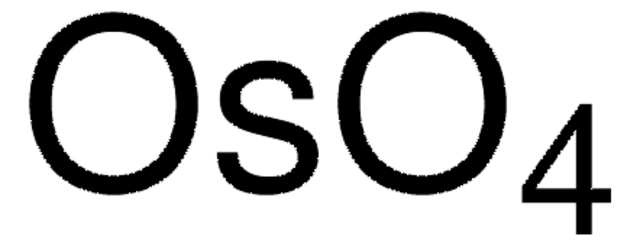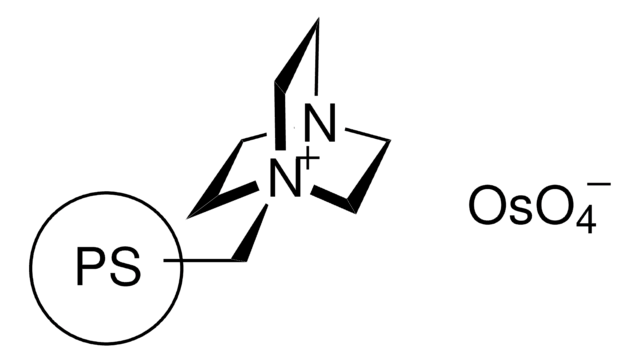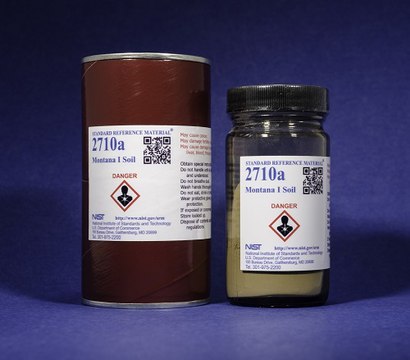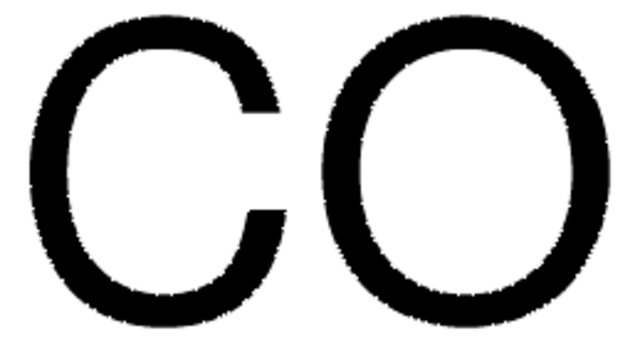658685
Os EnCat® 40
extent of labeling: 0.3 mmol/g Os loading
Synonym(s):
Osmium oxide, Osmium tetroxide, microencapsulated
Sign Into View Organizational & Contract Pricing
All Photos(2)
About This Item
Empirical Formula (Hill Notation):
OsO4
CAS Number:
Molecular Weight:
254.23
MDL number:
UNSPSC Code:
12161600
PubChem Substance ID:
NACRES:
NA.22
Recommended Products
Quality Level
reaction suitability
core: osmium
reagent type: catalyst
reagent type: oxidant
extent of labeling
0.3 mmol/g Os loading
SMILES string
O=[Os](=O)(=O)=O
InChI
1S/4O.Os
InChI key
VUVGYHUDAICLFK-UHFFFAOYSA-N
General description
The product is osmium tetroxide encapsulated within a porous cross-linked polyurea matrix.
Application
Os EnCat® 40 in the presence of a secondary oxidant can transform alkyl and aryl olefins to their corresponding diols via dihydroxylation reaction.
Features and Benefits
Encapsulated OsO4 catalyst offers safety and handling advantages over conventional OsO4.
Legal Information
Os EnCat® technology.
EnCat is a registered trademark of Reaxa Ltd.
Signal Word
Danger
Hazard Statements
Precautionary Statements
Hazard Classifications
Acute Tox. 2 Dermal - Acute Tox. 3 Inhalation - Acute Tox. 3 Oral - Eye Dam. 1 - Skin Corr. 1B
Supplementary Hazards
Storage Class Code
4.1B - Flammable solid hazardous materials
WGK
WGK 3
Personal Protective Equipment
dust mask type N95 (US), Eyeshields, Gloves
Regulatory Information
新产品
Choose from one of the most recent versions:
Already Own This Product?
Find documentation for the products that you have recently purchased in the Document Library.
Steven V Ley et al.
Organic letters, 5(2), 185-187 (2003-01-17)
[reaction: see text] Osmium tetroxide has been microencapsulated in a polyurea matrix using an in situ interfacial polymerization approach. These microcapsules have been effectively used as recoverable and reusable catalysts in the dihydroxylation of olefins
OsO4·streptavidin: a tunable hybrid catalyst for the enantioselective cis-dihydroxylation of olefins.
Valentin Köhler et al.
Angewandte Chemie (International ed. in English), 50(46), 10863-10866 (2011-09-29)
F Wyss et al.
Veterinary pathology, 52(6), 1235-1242 (2015-01-27)
Pododermatitis is frequent in captive flamingos worldwide, but little is known about the associated histopathologic lesions. Involvement of a papillomavirus or herpesvirus has been suspected. Histopathologic evaluation and viral assessment of biopsies from 19 live and 10 dead captive greater
Yukihiko Sugita et al.
The Journal of general virology, 92(Pt 11), 2485-2493 (2011-07-29)
Negatively stained influenza virions sometimes show irregular morphology and are often referred to as pleomorphic. However, this irregular morphology has not been visualized when ultrathin-section transmission and scanning electron microscopies are used. This study focused on the effects of ultracentrifugation
Carsten Købler et al.
Analytical and bioanalytical chemistry, 406(16), 3863-3873 (2014-01-23)
Ultrastructural characterisation is important for understanding carbon nanotube (CNT) toxicity and how the CNTs interact with cells and tissues. The standard method for this involves using transmission electron microscopy (TEM). However, in particular, the sample preparation, using a microtome to
Our team of scientists has experience in all areas of research including Life Science, Material Science, Chemical Synthesis, Chromatography, Analytical and many others.
Contact Technical Service




